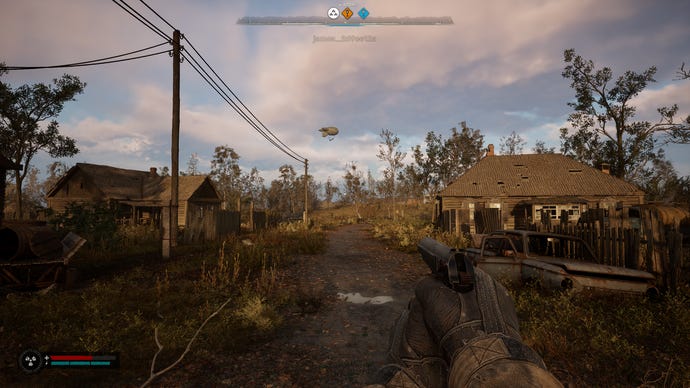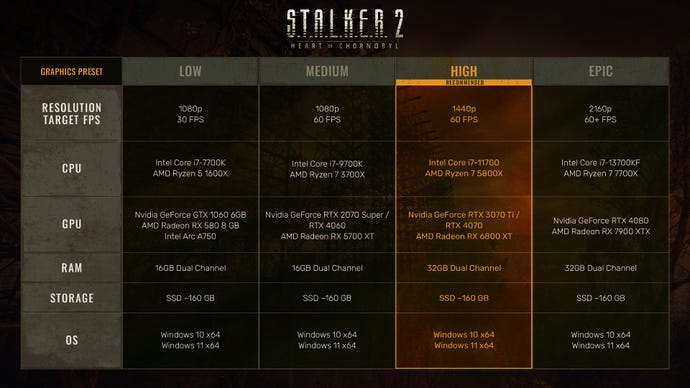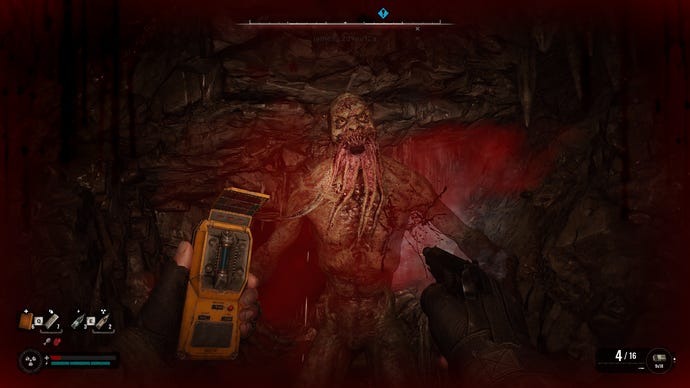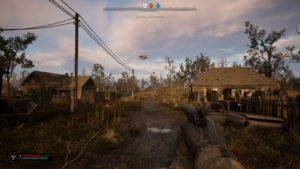I’ll stand by my review when I say that S.T.A.L.K.E.R. 2: Heart of Chornobyl is worth playing, in spite of it the many and varied ways in which it’s utterly broken. To be clear, though, it is utterly broken, in many and varied ways.
That makes my usual new-game performance analysis/settings guide song and dance harder to pull off, with or without the appropriate soundtrack. Is S.T.A.L.K.E.R. 2 in such dire technical straits that we should wait for a few patches before giving it a shake? And how can its best settings be anointed if some, particularly FSR 3 frame generation, simply don’t work as they should?
On balance, though, it probably is best to give an account of Heart of Chornobyl’s PC performin’ state as it comes, here and now. It’s already doing pretty well in the Steam charts and there’s likely many more playing via Game Pass, so that’s a lot of suffering stalkers who might be looking to get their framerates out of the rusty doldrums. Below, you’ll find my best attempt at something approaching advice, with the caveat that I would very much like it if GSC pumped out those fixes/improvements and left this whole article about as relevant and useful as a 20-year-old pot of radioactive borscht. Go on GSC, make me look dumb. Do it. Do it.

S.T.A.L.K.E.R. 2: Heart of Chornobyl system requirements and PC performance
First, let us remind ourselves of the hardware requirements, which were updated shortly before S.T.A.L.K.E.R. 2’s November 20 launch.

To summarise: crikey. The GTX 1060 and RX 580 showing up in the minimum section isn’t out of the ordinary for modern hi-fidelity games, but with the likes of the Core i7-9700K in the Medium tier and the RTX 4070 as a recommended GPU, Heart of Chornobyl was clearly never going to be an everyman’s survival FPS. The vastness of its weirded-out open world is also reflected in that gigantic 160GB SSD storage requirement.
Thing is, you could try to get by on minimum specs or you could return from the future with some fridge-sized RTX 8000; no matter your kit, you’re still going to be subject to S.T.A.L.K.E.R. 2’s wonkiness. I did a full main story playthrough on an RTX 3090 and still had to run a gauntlet of flashing textures, occasional crashes, or one-off oddities, like the cutscene that inexplicably ran at about 15fps (and subsequently killed general game performance until I restarted). There’s also plenty of textbook Unreal Engine 5 stuttering, despite the game insisting on a shader compilation every time you boot it, and even when nothing is actively on fire, there’s still going to be serious inconsistency with how S.T.A.L.K.E.R. 2 runs. In the sense that a rig that pumps out 60-70fps out in a field will drop to 30-40fps in a busy settlement.
I chose one of these trading hubs as a benchmarking test ground, as it would give the best indication of whether certain hardware really could handle the heat. Some good news did emerge: the GTX 1060 could indeed make do at 1080p, averaging 33fps on the Low preset with some help from FSR in Performance mode. My entry-level gaming laptop, with an RTX 4050, initially fell short, scoring 23fps on Low with Quality-level DLSS – but this shot up to 48fps after enabling DLSS 3’s frame gen, which S.T.A.L.K.E.R. 2 supports on all RTX 40 series cards.
Oddly, however, swapping in more capable components only raised concerns. The usually nimble RTX 4060 could only barely cope with the Epic preset at native 1080p, averaging 33fps, and worse, dropping all the way to Low only bumped that up to 45fps. That ain’t good for any hopes of teasing big performance improvements out of the quality settings.

Up at 1440p, the RTX 3070 underperformed, just scraping 32fps on Epic with DLSS on Quality. Dropping to High also didn’t help much, only nudging that up to 38fps, and nor did reducing DLSS to Balanced mode – back on Epic that only got me 34fps, a mere 2fps uptick.
In general, the upscaling options – DLSS, FSR, TSR, and TAA – all do less than you’ve probably come to expect them to. DLSS 3 frame gen is more helpful, nearly doubling the RTX 4060’s 1080p/Epic result to 61fps, but it does add a touch of input lag even with the latency-cutting Nvidia Reflex enabled. Worse, I couldn’t get FSR 3’s own frame generation to work at all on modern graphics cards, and while it could on the GTX 1060, the results were blurry-looking and made sluggish by even more input lag than DLSS 3.
S.T.A.L.K.E.R. 2 also doesn’t scale very well with high-end GPUs, and in the RTX 4070 Ti’s case, returned some downright mystifying results. With the Epic preset and Quality DLSS enabled, this averaged 34fps at 1440p and 35fps at 4K, which is… just… no. That’s not how resolutions work, RTX 4070 Ti. The significantly brawnier RTX 4090, meanwhile, could only manage a additional frames at 4K, ending up at 39fps with the same settings. Again, adding DLSS 3 helped, turning the RTX 4070 Ti’s 35fps into 58fps and the RTX 4090’s 39fps into 68fps, but still, I’d expect more from these cards even in a punishing UE5 game.
The Steam Deck? Forget it – S.T.A.L.K.E.R. 2 doesn’t even seem to acknowledge its inputs, making it impossible to get past the EULA. That might be for the best, though. I suspect actually trying to run the game would kill the Deck’s widdle APU on the spot.

S.T.A.L.K.E.R. 2: Heart of Chornobyl best settings guide
Let’s not bother with running through every single quality setting here; when the difference between Epic and Low is as little as 12fps, you can guess how most of the 25-odd individual settings won’t have any real impact on performance. I did test them all, on the RTX 4060, and found a few that can contribute the extra frame or two here and there, so you could try the following combination to beat Epic-level performance without making unnecessary cuts. Just don’t expect to reach much higher than that without DLSS 3 support; like Warhammer 40,000: Space Marine 2, S.T.A.L.K.E.R. 2 is the kind of game that mainly expects you to take the framerates you’re given.
- Texture quality: Medium
- Hair: Medium
- Object details: Medium
- Effects details: Medium
- Materials: Medium
- Upscaling method/Upscaling quality: DLSS on Balanced, or TSR on Ultra Quality
- Fog: Medium
- Foliage quality: Low
- Everything else: Epic preset equivalent
On my RTX 4060, this combination averaged 39fps, which is just 1fps faster than the High preset and 4fps slower than Medium. Which doesn’t sound like much of an improvement, but I found thIS combination produced less noticeable framerate drops and stuttering than High, while maintaining more of the Epic preset’s visual luxuries than Medium does.
Really, though, hammering any serious performance boost out of S.T.A.L.K.E.R. 2 comes down to one issue: does your PC support DLSS 3? If so, do try that out; adding it to the above settings sent that 39fps up to 78fps, which is much more becoming of the RTX 4060. If not, well, better hope for a miracle in those patches. I can’t really endorse FSR 3 frame gen as an alternative – even when it works, it’s offputtingly blurry, and the amount of input lag it adds could very easily muck up the flow of S.T.A.L.K.E.R. 2’s tense, corner-peeking gunfights. In fact, even basic FSR upscaling is awash with messed-up detailing, especially at far distances, hence why I’ve gone for the engine’s built-in TSR upscaler as an alternative for non-RTX systems.
I think S.T.A.L.K.E.R. 2 can and should succeed while carrying a degree of jank. Indeed, historically that’s been one of the series’ defining, uh, qualities. But stuff like DLSS barely adding any frames, or cutscenes breaking performance, is both lacking in that overambitious charm and, crucially, fixable. Here’s hoping for some tangible updates, and that the only headaches that come from playing this game are the ones caused by leather-skinned psi mutants trying to reverse-sear our brains.
ظهرت في الأصل على www.rockpapershotgun.com

